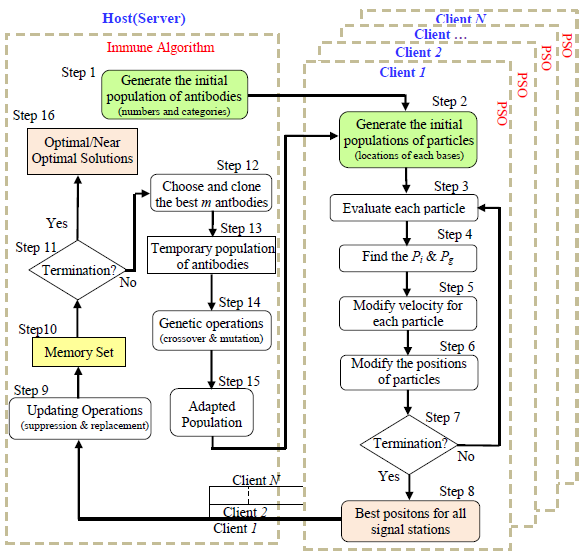Using a Hybrid Evolutionary Algorithm for Solving Signal Transmission Station Location and Allocation Problem with Different Regional Communication Quality Restriction
DOI:
https://doi.org/10.46604/ijeti.2020.5054Keywords:
location-allocation problem, hybrid evolutionary approach, immune algorithm, particle swarm optimizationAbstract
This study aims to investigate the signal transmission station location-allocation problems with the various restricted regional constraints. In each constraint, the types of signal transmission stations and the corresponding numbers and locations are to be decided at the same time. Inappropriate set up of stations is not only causing the unnecessary cost but also making the poor service quality. In this study, we proposed a hybrid evolutionary approach integrating the immune algorithm with particle swarm optimization (IAPSO) to solve this problem where each of the regions is with different maximum failure rate restrictions. We compared the performance of the proposed method with commercial optimization software LINGO®. According to the experimental results, solutions obtained by our IAPSO are better than or as well as the best solutions obtained by LINGO®. It is expected that our research can provide the telecommunication enterprise the optimal/near-optimal strategies for the setup of signal transmission stations.
References
E. C. Chukwuma, “Facility location-allocation modelling for bio-energy system in Anambra state of Nigeria: Integration of GIS and location model,” Renewable Energy, vol. 141, pp. 460-467, October 2019.
C. T. Cicek, H. Gultekin, and B. Tavli, “The location-allocation problem of drone base stations computers & operations research,” Computers & Operations Research, vol. 111, pp. 155-176, November 2019
M. Alizadeh, J. Ma, N. Mahdavi-Amiri, M. Marufuzzaman, and R. Jaradat, “A stochastic programming model for a capacitated location-allocation problem with heterogeneous demands,” Computers & Industrial Engineering, vol. 137, article 106055, November 2019.
“5G,” https://en.wikipedia.org/wiki/5G, Wikipedia, 2018.
Z. Drezner and G. O. Wesolowsky, “On the best location of signal detectors,” IIE Transactions, vol. 29, no. 11, pp. 1007-1015, March 1997.
F. Plastria, Continuous location problems, in Facility Location: A Survey of Applications and Methods, Drezner, Z., ed., Springer-Verlag, New York, pp. 229-266, January 1995.
R.F. Love, J.G. Morris, and G.O. Wesolowsky, Facilities Location: Models and Methods, North-Holland, New York, 1988.
T. C. Chen, S. C. Wang, C. H. Wu, and K. W. Huang, “Using two-phase evolutionary computation approach for nonlinear constrained signal detectors allocation problems,” Journal of Intelligent and Fuzzy Systems, vol. 36, no. 2, pp. 1301-1310, March 2019.
N.K. Jerne, Clonal selection in lymphocyte network, in: G.M. Edelman, ed., Cellular Selection and Regulation in the Immune Response, Raven Press, New York, 1974.
B. Geng, L. Jiao, M. Gong, L. Li, and Y. Wu, “A two-step personalized location recommendation based on multi-objective immune algorithm,” Information Sciences, vol. 475, pp. 161-181, February 2019.
T. C. Chen, “IAs based approach for reliability redundancy allocation problems,” Applied Mathematics and Computation, vol. 182, no. 2, pp. 1556-1567, November 2006.
Y. Jiang, K. Hao, X. Cai, and Y. Ding, “An improved reinforcement immune algorithm for agricultural resource allocation optimization,” Journal of Computational Science, vol. 27, pp. 320-328, July 2018.
J. Kennedy and R. Eberhart, Particle swarm optimization, Proc. of ICNN'95 - International Conference on Neural Networks, IEEE Press, August 1995, pp. 1942-1948.
Y. Shi and R Eberhart, A modified particle swarm optimizer, 1998 IEEE international conference on evolutionary computation proceedings. IEEE world congress on computational intelligence (Cat. No. 98TH8360), May 1998, pp. 69-73.
A. Sallama, M. Abbod, and S. M. Khan, “Applying sequential particle Swarm optimization algorithm to improve power generation quality,” International Journal of Engineering and Technology Innovation, vol. 4, no. 4, pp. 223-233, October 2014.
C. L. Lu and T. C. Lin, “Improved SVM classifier incorporating adaptive condensed instances based on hybrid continuous-discrete particle swarm optimization,” Advances in Technology Innovation, vol. 1, no. 2, pp. 53-57, September 2016.
Y. C. Hsieh, Y. C. Lee, P. S. You, and T. C. Chen, “An immune based two-phase approach for the multiple-type surveillance camera location problem,” Expert Systems with Applications, vol. 36, no. 7, pp. 10634 -10639, September 2009.
Y. Shi and R. C. Eberhart, “A modified particle swarm optimizer,” IEEE International Conference on Evolutionary Computation Proceedings. IEEE World Congress on Computational Intelligence (Cat. No.98TH8360), May 1998, pp. 69-73.
Z. Michalewicz, Genetic algorithms+ data structures= evolution programs, 3rd ed. Springer-Verlag Berlin Heidelberg: NY, 1996.

Published
How to Cite
Issue
Section
License
Copyright Notice
Submission of a manuscript implies: that the work described has not been published before that it is not under consideration for publication elsewhere; that if and when the manuscript is accepted for publication. Authors can retain copyright in their articles with no restrictions. Also, author can post the final, peer-reviewed manuscript version (postprint) to any repository or website.

Since Jan. 01, 2019, IJETI will publish new articles with Creative Commons Attribution Non-Commercial License, under Creative Commons Attribution Non-Commercial 4.0 International (CC BY-NC 4.0) License.
The Creative Commons Attribution Non-Commercial (CC-BY-NC) License permits use, distribution and reproduction in any medium, provided the original work is properly cited and is not used for commercial purposes.







.jpg)


